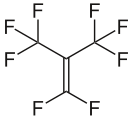Perfluoroisobutene
| |||
| Names | |||
|---|---|---|---|
| IUPAC name
1,1,3,3,3-pentafluoro-2-(trifluoromethyl)prop-1-ene | |||
| Other names
Perfluoroisobutene, Perfluoroisobutylene, Octafluoroisobutylene, Octafluoro-sec-butene, PFIB | |||
| Identifiers | |||
| 382-21-8 | |||
| 3D model (Jmol) | Interactive image | ||
| ChemSpider | 55060 | ||
| ECHA InfoCard | 100.108.743 | ||
| EC Number | 609-533-9 | ||
| PubChem | 61109 | ||
| RTECS number | UD1800000 | ||
| |||
| |||
| Properties | |||
| C4F8 | |||
| Molar mass | 200.030 g/mol | ||
| Density | 8.2 g/l | ||
| Boiling point | 7.0 °C (44.6 °F; 280.1 K) | ||
| Except where otherwise noted, data are given for materials in their standard state (at 25 °C [77 °F], 100 kPa). | |||
| | |||
| Infobox references | |||
Perfluoroisobutene (PFIB), also known as 1,1,3,3,3-pentafluoro-2-(trifluoromethyl)prop-1-ene, is a fluorocarbon alkene. It is a hydrophobic reactive gas with boiling point at 7 °C. It is a strong electrophile.
PFIB is about 10 times as toxic as phosgene. Its inhalation can lead to pulmonary edema, which may be fatal. Onset of symptoms can take 1-4 hours after inhalation. Treatment is based on management of the pulmonary edema (usually with high-dose corticoids and other medication/measures) and associated disorders (e.g. heart failure, hypocalcemia etc.). Many cases resolve within 72 hours without major long-term effects.
In contact with water PFIB undergoes rapid hydrolysis, producing various reactive compounds and fluorophosgene.
PFIB is a product of pyrolysis of polytetrafluoroethylene (PTFE), one of the substances causing polymer fume fever.
It is a Schedule 2 substance of the Chemical Weapons Convention.

